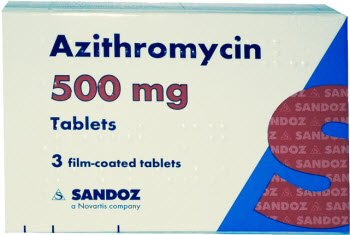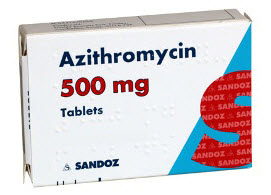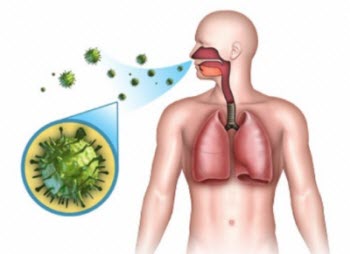
Azithromycin in the practice of the treatment of respiratory diseases in children
The paper discusses the history of azithromycin, the data on its clinical use in pulmonology.
Keywords:
Azithromycin, respiratory diseases, children.
It has been over 70 years since the beginning of serial production and clinical application of the amazing medicines called Zellman-Waxman, founder of streptomycin and erythromycin antibiotics. Drugs that target the fight against infectious agents. Currently, more than 20 known macrolide antibiotics. Optimal pharmacological characteristics, high antimicrobial activity, including against intracellular microorganisms, well tolerated macrolides allowed to occupy a leading position in the treatment of many diseases. As evidenced by the results of market research, currently modern macrolides (azithromycin, clarithromycin) are some of the most popular antibiotics. According to the reports of the European Society of Antimicrobial Chemotherapy (ESAC) macrolides occupy 2nd place on volume of consumption among the antibiotics that are used in ambulatory practice, second only to penicillin.
Antibiotics have revolutionized the natural course of many diseases caused by microbes, and continue to save the lives of millions of people. However, as the creation of new classes of drugs, and enhance the experience of their application in a number of molecules, along with antibacterial activity have been identified and other positive properties. An example of such a wide spectrum of clinical activity is well known to practitioners of different specialties macrolide - azithromycin.
In 1981, led by S. Dokic research group farmacy company PLIVA (Croatia) by incorporating nitrogen atoms in the lactone ring of erythromycin 14-member between 9m and 10m carbon atoms synthesized a new antibiotic - azithromycin, referred to the group of semi-synthetic macrolide antibiotic 15-member azalides in which azithromycin is the sole representative hitherto. At the same time on this molecule, scientists have worked the company "Pfizer". In 1986, between the two companies reached an agreement on the world market section. In Central and Eastern Europe, the drug is sold since 1988 under the brand name Sumamed, and since 1991 in Western Europe and the United States - Zithromax.
Active against many Gram-positive and Gram-negative pathogens, including intracellular - Chlamydia, Mycoplasma, Legionella, azithromycin has shown to be an effective and safe antibiotic, creating high concentrations in areas of inflammation. The mechanism of action of azithromycin is inhibition of protein synthesis in the cell of microorganism.
The drug binds to the 50S ribosomal subunit, thereby interferes with protein synthesis microbe.
According to the analysis of long-term (1998 to 2010), the dynamics of consumption of antibacterial drugs of different classes observed a steady increase in the consumption of modern macrolides. In particular, the sale of azithromycin (number of packages of the drug per 1000 persons) increased by 24.7%, while the figure in clarithromycin decreased by 9.9%. It is obvious that the reason for the popularity of the drug was an awareness of the importance of a number of previously studied pharmacological properties of azithromycin (possibility of short courses), the occurrence of dosage forms for parenteral use, as well as expanding the range of its clinical applications, including in pulmonology practice.
The nature of the antimicrobial action of macrolides bacteriostatic, but under certain conditions (depending on the type of microorganism, concentration of the antibiotic, inoculum size, and medium pH) against microorganisms such as Streptococcus pneumoniae and Str. pyogenes, it is possible, and the bactericidal effect. This feature is most pronounced is in Azithromycin by creating high intracellular concentrations. Additionally, azithromycin is characterized by a significant post-antibiotic effect against S.pneumoniae, S.pyogenes, Haemophilus influenzae, and Legionella pneumophila. At the same time duration post-antibiotic effect against Haemophilus influenzae and L.pneumophila exceeds that of clarithromycin.
Azithromycin is active against most potential respiratory pathogens, its significant differences are a higher activity against H.influenzae, including strains producing blaktamazy, and the highest among all the macrolide activity against Mycoplasma pneumoniae.
The pharmacokinetic parameters of azithromycin distinguish the drug from other macrolides. Specifically, azithromycin is more resistant to the action of hydrochloric acid gastric juice without inhibitory effects on microsomal cytochrome P450 (typical 14-member macrolides) and thus has a low probability of drug-drug interactions.
The unique properties of the drug are long half-life averaging 68 hours, allowing you to take it 1 time per day, and a high tissue affinity. The maximum accumulation of the drug is observed in lung tissue, fluids lining the mucosa bronchi and alveoli, the bronchial secretions, saliva, tonsils, middle ear, sinuses, mucous membrane of the gastrointestinal tract, the prostate gland, the conjunctiva and eye tissues, skin, bile, urethra, uterus, appendages and placenta. The antibiotic possesses the ability to accumulate in fibroblasts, alveolar macrophages and polymorphonuclear leukocytes by creating therein a concentration that significantly exceed those in serum. When migrating to phagocytes inflammatory focus operate transport function, delivering the antibiotic directly to the site of localization of bacteria, which under the influence of microbial stimuli is released from the cells of the drug that allows you to create high and long-term persistence of azithromycin concentration in the focus of infection.
Azithromycin is included in the domestic and international standards for the treatment of respiratory diseases, such as community-acquired pneumonia. Its effect is proven in clinical practice. In the United States in 2005 in the form of azithromycin for oral administration was the main drug recommended for initial therapy of these diseases (Hospital Medicine Consensus Reports, 2005). In recent consensus recommendations of the American Society of infectious disease / American Thoracic Society 2007 Azithromycin is recommended as the starting product for the empirical treatment of individuals without comorbidities and not receiving antibiotics past 3 months.
Comparison of the effectiveness of azithromycin with protected aminopenicillins showed almost the same clinical efficacy in the treatment of community-acquired pneumonia - 92-93%, which was confirmed clinically and radiologically after 22-26 days: in any case, then there was no recurrence. Bacteriological success was ascertained in 91.4% of cases, the treatment with azithromycin and 90.9% - amoxicillin / clavulanate. In conclusion, the authors noted that azithromycin is as effective and safe as amoxicillin / clavulanate in the treatment of community-acquired pneumonia in the outpatient adults.
The results of two Phase III studies indicate that a single dose of 2 g azithromycin in the form of microspheres correspond to alternative therapies CAP in adults XL clarithromycin or levofloxacin for 7 days.
Today has accumulated a large arsenal of data on the efficacy of azithromycin in respiratory bacterial infections in children. US pediatricians investigated the effect of azithromycin within 30 days (12 mg / kg on days 1-5, then on days 11-15 and 21-25) in children with adenotonzillyar hypertrophic obstructive apnea and nocturnal. The study found that rates of azithromycin are effective in improving the flow of sleep apnea caused adenotonzillar hypertrophy.
The leading role in the occurrence of acute bacterial tonsillitis / pharyngitis has hemolytic group A streptococcus (GABHS) - 15-30% of cases in children and 5-17% of adults were significantly less likely (5%) disease causing streptococci of groups C and G, and also other microorganisms - anaerobes, spirochetes, the causative agent of diphtheria. Drugs of choice for the treatment of acute bacterial tonsillitis are aminopenicillin. Children with allergies to blaktamy used macrolides. According to several studies, macrolides are not inferior aminopenicillins efficacy of therapy, providing reliable eradication of GABHS tonsils. Azithromycin is more attractive because of the possibility of its application a short 3 day course.
The effect of a single application of the drug (30 mg / kg) in acute otitis media in children has been assessed in the international double-blind study in which it was concluded that a single administration of azithromycin as effectively as exchange treatment with high doses of amoxicillin, whereas the frequency adverse events was lower and higher frequency therapeutic cooperation. These Turkish researchers suggest that the effectiveness of amoxycillin / clavulanate (45 / 6.4 mg / kg / day in 2 divided doses for 10 days) and azithromycin (10 mg / kg 3 days) is identical to the treatment of acute otitis media.
The main causative agents of acute bacterial rhinosinusitis are S.pneumoniae (20-43% of cases) and H.influenzae (22-35%), less frequent microbiological findings are M.catarrhalis, BGSA, S.aureus and other microorganisms. In less severe OBRS (if clinical symptoms persist for more than 10 days without improvement or progress) in patients who did not receive antibiotics in the previous 4 weeks, the drug of choice is amoxicillin. When allergy blaktamy used macrolides. Azithromycin is more attractive due to the possibility of using short-course (3 days).
In a randomized trial of the efficacy of azithromycin (30 mg / kg / day) in 190 children aged 1 to 14 years with acute and recurrent respiratory infections in the history of short-term (1 month), clinical success was observed more frequently among children with the presence of atypical microflora - chlamydia and mycoplasmas. Long term (6 months) clinical success was observed more frequently in patients who received azithromycin with symptomatic treatment, regardless of the presence or absence of atypical microflora or other pathogens, although among those with atypical pathogens effect was stronger.
T. Murray et al in 2007, prepared a review of the pathogenesis of diseases caused by P.aeruginosa biofilms in the composition, existing in chronic pulmonary involvement. It was noted that the formation of biofilms in the lung in cystic fibrosis probably occurs under anaerobic conditions, under the control of the sensing mechanism of bacterial quorum bacteria and enhanced airways environment factors. Pseudomonas aeruginosa recognizes conditions and selects the option of chronic or acute infection colonizing depending on the conditions in the airways of the patient. Sumamed is a macrolide that has shown its effect in cystic fibrosis by disrupting biofilms formed P.aeruginosa. This opens up a new way of treatment based on molecules, stopping the formation of biofilms by disrupting bacterial quorum.
Many years of clinical and bacterial monitoring conducted at the Research Institute of Pediatrics NTSZD Medical Sciences, revealed that the microbial spectrum of chronic bronchopulmonary diseases in children in the period of exacerbation is mainly represented by two pneumotropic microorganisms. Thus H.influenzae causative factor is a dominant infectious process - in 61-70%, of which 27% of it is in association with the pneumococcus. Streptococcus pneumoniae were isolated from 36% of patients. Much less was determined part in the etiology of chronic inflammation Moraxella catarrhalis (4-10%), Proteus mirabilis (2,2%), Klebsiella pneumoniae (1,1%), Streptococcus pyogenes (1,1%), S.aureus (0, 1 %).
In recent years, the rise in prevalence of so-called atypical intracellular microorganisms persisting for respiratory diseases in children and adults: Chlamydia trachomatis, Ch.pneumoniae, Mysoplasma pneumoniae, Legionella pneumoniae. Atypical pathogens of pneumonia in children aged 1-6 months are detected in more than 10-20% of cases, it is often Ch.trachomatis, less Mycoplasma hominis. M.pneumoniae determined in 10-15% of patients aged 1 to 6 years. At school age (7-15 years old) increased frequency of pneumonia, especially caused by M.pneumoniae (20-40%) and Ch.pneumoniae (7-24%).
These infections are also defined in recurrent bronchitis (15-20%) and exacerbation of chronic bronchopulmonary diseases (chlamydia infection - 30-40%) in children. Frequency of participation atypical bacteria in community-acquired pneumonia in adults is 8-30%. Moreover, almost every second patient noted the association of pneumococcal and chlamydial or mycoplasma infection.
RF Khamitov and colleagues published data on open, randomized single-blind, placebo-controlled study of the effect of infection Shlamydophila pneumoniae in asthma. The authors noted that in patients with stable asthma recorded a high level (52%) serological evidence of clinically asymptomatic infection hlamidofiloy exerting an adverse impact on the severity of the clinical manifestations of the disease and the deterioration of the quality of life of patients. Against the background of antibiotic treatment with azithromycin marked decrease in the proportion of infected individuals in need of constant pill glucocorticosteroids, from 43 to 29%, this figure (11%) remained unchanged among uninfected subjects.
According to our data, 62.5% of children with asthma, respiratory tract infection is detected Chlamydophila pneumoniae, among them active during infection is determined at 74.1%, latent - in 25.9% of children. And for children with asthma in combination with respiratory chlamydia, characterized by a decrease in the frequency of 3.8 times the related atopic diseases compared with those not infected with Chlamydophila pneumoniae patients; 1.5 - 2.8 times - rates of sensitization to food, household, pollen, epidermal, medication and allergens increase 3 times the incidence of complicated forms of acute respiratory viral infections. The inclusion of macrolides and interferons in the basic treatment of infected Chlamydophila pneumoniae in patients with bronchial asthma has allowed to increase the effectiveness of therapeutic measures (reducing the frequency and duration of exacerbations 5 and 5.5 times, respectively, the number of intercurrent diseases - 2.5 times).
Today not antibiotics effects of macrolides - immunomodulating and anti-inflammatory - are in the nature paradigm. However, it noted that all of the data on the immunomodulatory effects of azithromycin, clarithromycin and roxithromycin have been proven only for original drugs, in particular Sumamed, unproven and may not be transferred to their generics.
Clinical pharmacologists from the USA analyzed the Medline database from 1966 and made the following conclusions:
1) study the immunomodulatory effect of azithromycin in chronic pulmonary diseases showed stable positive effect; This effect, together with an inhibitory effect on the biofilm makes this side of action of azithromycin is very useful;
2) this advantage is permanent, even if the macrolide in community-acquired pneumonia were added to another agent, also affects the atypical pathogens, indicating neantibakterialny effect;
3) recent studies have anti-inflammatory properties of azithromycin suggest that it may have not previously known biphasic effect on inflammation: improved host defense mechanisms soon after the first application, leading to reduction of local infection / inflammation in the subsequent period.
Noted the following not antibiotics effects of azithromycin:
- Modulating effect on phagocytosis, chemotaxis and apoptosis of neutrophils;
- Suppression of oxidative "explosion", thereby reducing the formation of highly active oxygen species capable of damaging cells and tissues;
- Inhibition of the synthesis and secretion of proinflammatory cytokines - interleukins, tumor necrosis factor alpha;
- Increased secretion of anti-inflammatory cytokines - interleukin;
- Reduction of bronchial hyperreactivity, decrease bronchoconstriction due to inhibition of production of acetylcholine.
Azithromycin suppresses early interleykina8 product has a high degree of penetration of polymorphonuclear leucocytes and is retained in them that increases the ability to phagocytosis and anti-infective protection.
All this contributes to a more rapid resolution of inflammation, reduction of symptoms, including the relapsing and chronic bronchopulmonary diseases.
In recent years, the study of the effect of azithromycin on the proteins that form intercellular junctions in the respiratory epithelium, the new data were obtained on neantibakterialnyh properties of azithromycin, which are reversible and dose dependent. It was found that azithromycin increases the electrical resistance of the respiratory epithelium due to the impact of the regulation of transport of ions and solutions through the intercellular space and regulate protein localization intercellular epithelium contacts (klaudin1, klaudin4, adhesion molecule A) to ensure the integrity of epithelial tissue and is a key component of structural and functional protection airway epithelium. These properties not possessed by other antibiotics. What is important is the absence of negative influence of azithromycin on the viability of the respiratory epithelium.
Clinical and bacteriological monitoring susceptibility basic pneumotropic bacteria held in the Research Institute of Pediatrics NTSZD RAMS revealed that respiratory diseases in children St.pneumoniae retains high sensitivity to drugs aminopenitsillinovogo series and macrolides. There is also its high sensitivity to cephalosporins with natural resistance to aminoglycosides, which corresponds to the results of a multicenter study of antibiotic resistance, made in Russia.
H.influenzae also retains high sensitivity to azithromycin, amoxicillin, amoxicillin / clavulanate, chloramphenicol (chloramphenicol), aminoglycosides and cephalosporins II-III generation. Low and medium activity have other macrolides and cephalosporins I generation while maintaining high sensitivity to azithromycin and drugs cephalosporin II-III generation.
The above data on the etiology and the sensitivity of the main pneumotropic bacteria and intracellular prevalence of atypical pathogens in acute and chronic respiratory diseases in children justify the application of the new macrolides, one of which is azithromycin (Sumamed).
Sumamed is available as:
- Suspension 100 mg / 5 ml with shpritsemdozatorom - children up to three years;
- Fort suspension 200 mg / 5 ml - Children from 3 years of age and older;
- Tablets 125 mg - Children from 3 to 10 years;
- Capsules of 250 mg and 500 mg tablets - adults.
When the five-day course of treatment for the first day of drug is given in a dose of 10 mg / kg of body weight per day, then the next day 4 - 5 mg / kg per day. When a three-day course of treatment - a daily 10 mg / kg per day. When pulsterapii single dose of 30 mg / kg per day. The suspension can be applied Sumamed in young children who have reached 5 kg body weight. Sumamed form for intravenous administration is used since 16 years.
Benefits Sumamed:
- Convenient dosage form for infants and older children;
- Taking the drug once a day;
- Comfortable short courses: three days, five days, pulse therapy;
- The possibility of using the drug in the sequential therapy.
An important feature is the ability to maximize Sumamed penetrate the bronchial secretions and lung tissue and accumulate in them, which helps to optimize antibiotic therapy for respiratory diseases.
The main indications for the purpose of Sumamed in respiratory diseases in children are:
- Inflammatory diseases of the respiratory system (rhinosinusitis, bronchitis, pneumonia), Chlamydia and Mycoplasma etiology;
- Uncomplicated community-acquired pneumonia of mild or moderate flow at fixed or probable etiology (including sensitivity);
- Acute recurrent bronchitis and chronic inflammatory bronchopulmonary disease (mild to moderate);
- Ineffectiveness of beta-lactam antibiotics;
- Intolerance of drugs penicillin;
- Existence of a common allergic history or allergies the child;
- The need for antibiotic therapy to patients with bronchial asthma.
Analysis of the literature and our own observations allow to conclude that azithromycin (Sumamed) is an effective antibacterial drug for the treatment of community-acquired uncomplicated pneumonia and the drug of choice in the treatment of mycoplasma and chlamydial pneumonia, as well as exacerbation of chronic bronchopulmonary disease (mild and moderate flow) in children. High sensitivity to azithromycin basic pneumotropic and persistent intracellular pathogens, ease of use, availability of pediatric formulations, reducing the multiplicity of receiving up to once per day for short courses, high efficiency and absence of marked adverse events allow us to recommend Sumamed for widespread use in pediatric practice with light and severe respiratory diseases, both in hospitals and in outpatient conditions in infants and older children.






